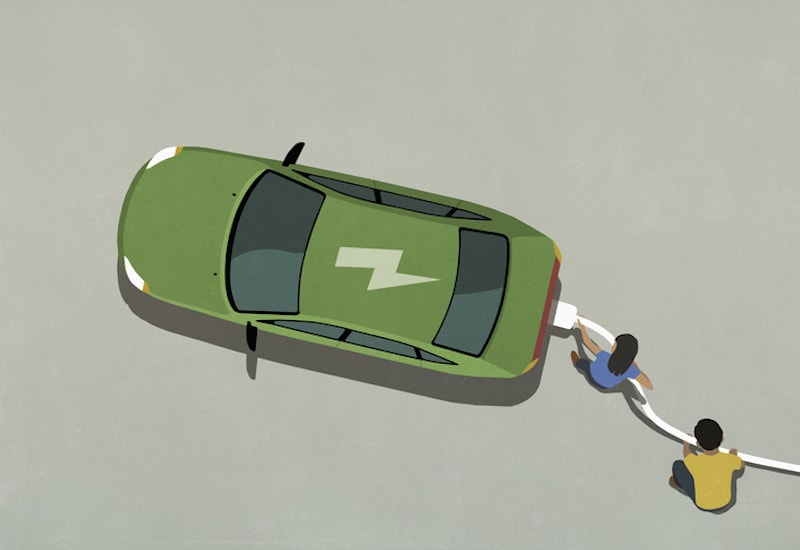Thursday, April 20, 2023
Several initiatives are now underway to improve the separation and recovery of materials in electric vehicle batteries. This will be key to making this industry 100% sustainable.
By Marta Ayala
The electric vehicle is here to stay, or at least that is the intention of most actors linked to mobility, with the aim of curbing CO2 emissions and climate change. In the EU, cars that run exclusively on fossil fuels will no longer be sold from 2035,which will lead to a significant increase in the sale of electrified vehicles. If these cars are charged using green energy, they will be almost completely sustainable. However, there is still one aspect that prevents the green mobility loop from being closed: what should be done with the batteries when they stop working?
If they are simply discarded, the automotive industry will be eliminating gas emissions while generating a new problem: battery waste. But can't they be recycled? Even if the answer is yes, the problem lies in the difficulty of separating the materials and the high cost involved. Batteries in today's electric cars are composed of lithium, nickel, cobalt and graphite, among other materials. Currently, separating these materials for recycling or reuse is too costly because of the large amount of energy required for the processes, which are often time-consuming.
"The complexity of lithium-ion batteries makes it very difficult to establish a robust and generic recycling procedure," concludes the report Recycling of Lithium-ion Batteries from Electric Vehicles by the Spanish Technology Platform for Energy Efficiency. In other words, each vehicle manufacturer has its own way of assembling the materials, which makes it impossible to establish a single way of recycling. In addition, since this is a “constantly changing and developing” field, the batteries that begin to be marketed in five, ten or fifteen years "may be quite different from those currently on the market because recycling techniques must adapt with the times." Despite these barriers, recycling is unavoidable, at least in order to comply with the EU regulations which, from 2024 and progressively, will require car manufacturers to recover battery materials. Thus, a growing number of initiatives, processes and technologies are emerging that seek to change the paradigm and consolidate efficient and cost-effective recycling.
From a battery disassembling robot to ultrasonics
The University of Agder (Norway), for example, has responded to the task of separating materials by developing a robot capable of disassembling batteries more easily and efficiently. It streamlines the process and offers a solution to the problem of standardization, since it works with 300 different types of batteries.

Also in northern Europe, this time at the Faraday Institution of the University of Leicester and the University of Birmingham, research has resulted in a new form of recycling. Today there are two techniques to recover materials: hydrometallurgy (by dissolution) and pyrometallurgy (by smelting). But the institution has found a third way: ultrasound. The investigation has concluded that ultrasound is 100 times faster, more environmentally friendly and recovers materials with greater purity, which makes it a promising option for recycling.
In the United States, flotation tanks are being explored as a possible solution. Scientists at the ReCell Center have succeeded in separating the materials using a technique similar to that used by the mining industry: a froth flotation tank has managed to recover them with 95% purity. Elements that repel water float and those that absorb water sink.
The University of Agder robot was made possible by European funding; the ReCell center is funded by the US Department of Energy; and gigafactories (battery factories with a production capacity of more than one gigawatt hour) are starting to open in Europe and America. These three facts suggest that there is a budding industry around battery recycling. The circular economy is opening the way for a new area of the economy in the very near future. Brands and governments are aware of this, which is why Sweden, Germany, Poland and Spain will have factories for producing and recycling electric car batteries in the coming years.
Laying the foundations for a recycling industry implies not only environmental advantages, but also eliminating the geopolitical risk of depending on materials from third countries. This will generate employment in a field yet to be explored while lowering the cost of vehicles thanks to the reuse of materials. In addition, research in the battery recycling industry will lead to the discovery of new ways of reusing batteries, giving them a second life before they are discarded. One example is the Johan Cruijff Stadium in Amsterdam, Ajax's soccer field, where an energy storage system based on used batteries from electric vehicles has been lighting games, events and concerts since 2018. This is another indication of how science and creativity, along with hard work and environmental awareness (and despite the unexpected speed bumps), always find new ways to come full circle.
¿Te ha parecido interesante?





